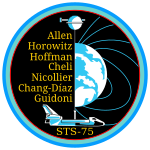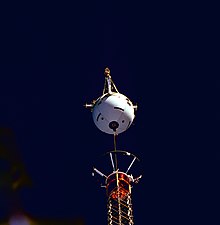STS-75
| Mission emblem | |||
|---|---|---|---|

|
|||
| Mission dates | |||
| Mission: | STS-75 | ||
| COSPAR-ID : | 1996-012A | ||
| Crew: | 7th | ||
| Begin: | February 22, 1996, 20:18:00 UTC | ||
| Starting place: | Kennedy Space Center , LC-39B | ||
| Landing: | March 9, 1996, 13:58:21 UTC | ||
| Landing place: | Kennedy Space Center, Lane 33 | ||
| Flight duration: | 15d 17h 41m 25s | ||
| Earth orbits: | 252 | ||
| Rotation time : | 90.5 min | ||
| Track height: | 294 km | ||
| Orbit inclination : | 28.5 ° | ||
| Covered track: | 10.4 million km | ||
| Payload: | TSS | ||
| Team photo | |||
 v. l. No. Maurizio Cheli, Umberto Guidoni, Scott Horowitz, Andrew Allen, Jeffrey Hoffman, Franklin Chang-Diaz, Claude Nicollier |
|||
| ◄ Before / After ► | |||
|
|||
STS-75 ( english S pace T ransportation S ystem) is a mission designation for the US Space Shuttle Columbia (OV-102) NASA . The launch took place on February 22, 1996. It was the 75th space shuttle mission and the 19th flight of the Columbia space shuttle.
team
- Andrew Allen (3rd space flight), commander
- Scott Horowitz (1st spaceflight), pilot
- Franklin Chang-Diaz (5th spaceflight), mission specialist
-
Maurizio Cheli (1st space flight), Mission Specialist ( ESA / Italy )


- Jeffrey Hoffman (5th Spaceflight), Mission Specialist
-
Claude Nicollier (3rd space flight), Mission Specialist ( ESA / Switzerland )


-
Umberto Guidoni (1st space flight), Payload Specialist ( ASI / Italy )

Mission description
The focus of the mission of the second test were tethered satellite TSS (Tethered Satellite System, mass about 700 kg) to develop new energy sources and new methods, the upper atmosphere to explore, as well as work to acquire new materials and a better understanding of certain physical phenomena.
The TSS tethered satellite had already been on board for the STS-46 mission in 1992 , but the desired results could not be achieved at the time, as the retaining cable jams when it is deployed and the satellite therefore only covers a distance of 260 meters instead of the planned 20 kilometers from the space shuttle. The greater part of the crew of STS-46 was accordingly deployed again on STS-75: In addition to the commander Andrew Allen (still a pilot on STS-46), mission specialists Jeffrey Hoffman, Franklin Chang-Diaz and Claude Nicollier were also on board again. The Italian payload specialist Franco Malerba had been replaced by his then double Umberto Guidoni from the Italian space agency ASI .
The main aim of the tethered satellite was to check whether and how much electrical energy can be obtained with this new process. The shuttle and the satellite, linked by a 20-kilometer cable, moved at great speed through the earth's magnetic field . A high voltage is thereby induced. An electrical current is to flow through the cable to the shuttle, where its energy can be used (investigation complexes DCORE / SCORE). The excess charges are then transported back into the ionosphere by so-called electron guns. With TSS, many side effects of this process have been examined more closely. Current strength and voltage were measured (SETS experiment), the behavior of charged particles in the vicinity of the satellite was investigated (ROPE), the electrical potential around the satellite was determined and the low-frequency waves generated there were identified (RETE). The strength and fluctuations of the magnetic field were also investigated (TEMAG), as were the density of charged particles (electrons and ions) around the shuttle (SPREE) and vibrations of the holding cable or satellite (IMDN / TEID). Theoretical models of electrodynamic processes in the ionosphere were also checked (TMST). In addition, such a long line can of course also be used as an antenna for long-wave radiation. Therefore measuring devices for the quantification of radio signals from space and from the earth were part of TSS (EMET / OESSE). Finally the whole process was recorded with a special camera (TOS). In the evaluation, the interactions between the satellite and the upper atmosphere and the vibrations of the holding cable were taken into account.
After the start of the Columbia, various systems of the tethered satellite experiment were first put into operation on a trial basis. Serious computer problems arose, which could be resolved by replacing a cable and restarting the systems involved. One day later than planned, the 11.3-meter-high retaining mast mounted on a Spacelab pallet was erected and the satellite was released from the loading bay. A plastic-sheathed copper cable was unrolled. The satellite had its own nitrogen propulsion system that was used to maneuver it away from the shuttle. The plan was to roll out to 20.7 kilometers for 22 hours and then gradually roll in with several stops for extensive plasma measurements. However, the retaining cable tore after about 5 hours shortly before reaching the maximum length. Until then, the measurements had shown a maximum voltage of 3500 volts and a maximum current of 480 milliamps. At 10 keV, the electrons sent back reached ten times the initial energy, the acceleration values on board the satellite were less than a thousandth of the acceleration due to gravity (0.0009 g). After exiting the metal tips of the electron guns, the electron cloud expanded into a cylinder, depending on the potential of the orbiter, the local ionospheric density and the direction of the beam. On the 6th day of the flight, additional equipment was activated by radio command so that data about the upper atmosphere could also be collected. This included ion and electron density determinations as well as measurements of the electric and magnetic field strengths. The measurement results were transmitted until the batteries of the satellite were exhausted. Despite the loss, TSS brought a lot of valuable data. It turned out that the generation of energy by a tethered satellite was far more effective than theoretical models had predicted.
Thereafter, the Columbia crew dedicated themselves to the microgravity and combustion experiments as planned. Lead selenium telluride crystals were produced in a special melting furnace (AADSF). At the same time, the minimum accelerations caused by the braking effect of the atmosphere and the movements of the astronauts were measured (SAMS / OARE). The purpose of the investigations was to determine what influence these minimal perturbations have on directional crystal growth. The solidification process is very slow. The apparatus has several zones in which the temperature can be varied between 340 and 870 ° C. Lead selenium telluride is a semiconductor material that is used in the manufacture of infrared detectors and lasers .
MEPHISTO was the name for an apparatus with which interesting solidification phenomena were studied in parallel on earth and in weightlessness. It was about the influence of gravitation-dependent convection and sedimentation on the production of metals and metal alloys. Three tin-bismuth crystals were grown during the STS 75 mission. The shape of the solidification front was made visible by current impulses. Solid-state research also included the Isothermal Dendrite Growth Experiment (IDGE). A material (SCN = succinonitrile), which when solidified shows a behavior similar to metals, but is transparent, was caused to solidify by cooling. Tree-like growths, so-called dendrites, developed. Their shape allows statements about the course of the solidification, which were recorded with video and film cameras.
The behavior of small xenon clouds at the critical point was also filmed. The critical point is a state at which the boundary between liquid and gas disappears. Xenon is transparent in the gaseous state and whitish as a liquid. With the help of reflected laser light, the size and shape of the liquid sub-areas could be precisely observed. In the Critical Fluid Light Scattering Experiment , which was named Zeno after a Greek philosopher of antiquity, statements about the course of changes in state and changes in magnetic properties were specified.
In addition, three experiments to investigate combustion processes in weightlessness were carried out in the middle deck. They were in a so-called glove box and were hermetically sealed from the environment. Research was carried out into the spread of flames as a function of air flow and temperature (FFFT), the ignition of ash-free filter paper by thermal radiation (RITSI) and the formation of soot, its distribution and movement in quasi-stationary flames. To this end, various sources of fire were examined, from a normal candle flame to paper and insulation material to Teflon and Kapton (CSD). As with almost every shuttle flight, a facility for producing the purest protein crystals for medical research (CPCG) was also on board this mission . A new vapor diffusion apparatus for protein crystallization was inaugurated with nine samples of new therapeutic agents against infections, cancer and hormonal disorders .
For the first time, the crew worked in three shifts. In addition, each crew member had half a day off. The flight was initially extended by one day for additional experiments and later due to bad weather at the intended landing site. On March 9th, Columbia landed in Cape Canaveral with tons of data .
See also
Web links
- NASA Mission overview (English)
- Video summary with comments of the crew (English)
- NASA video of Mission (English)

